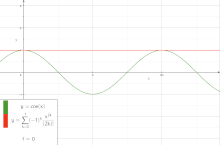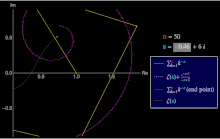
In mathematics, a series expansion is a technique that expresses a function as an infinite sum, or series, of simpler functions. It is a method for calculating a function that cannot be expressed by just elementary operators (addition, subtraction, multiplication and division).[1]
The resulting so-called series often can be limited to a finite number of terms, thus yielding an approximation of the function. The fewer terms of the sequence are used, the simpler this approximation will be. Often, the resulting inaccuracy (i.e., the partial sum of the omitted terms) can be described by an equation involving Big O notation (see also asymptotic expansion). The series expansion on an open interval will also be an approximation for non-analytic functions.[2]
Types of series expansions
There are several kinds of series expansions, listed below.
Taylor series
A Taylor series is a power series based on a function's derivatives at a single point.[3] More specifically, if a function is infinitely differentiable around a point , then the Taylor series of f around this point is given by
under the convention .[3][4] The Maclaurin series of f is its Taylor series about .[5][4]
Laurent series
A Laurent series is a generalization of the Taylor series, allowing terms with negative exponents; it takes the form and converges in an annulus.[6] In particular, a Laurent series can be used to examine the behavior of a complex function near a singularity by considering the series expansion on an annulus centered at the singularity.
Dirichlet series

A general Dirichlet series is a series of the form One important special case of this is the ordinary Dirichlet series [7] Used in number theory.
Fourier series
A Fourier series is an expansion of periodic functions as a sum of many sine and cosine functions.[8] More specifically, the Fourier series of a function of period is given by the expression
where the coefficients are given by the formulae[8][9]
Other series
In acoustics, e.g., the fundamental tone and the overtones together form an example of a Fourier series.
Legendre polynomials: Used in physics to describe an arbitrary electrical field as a superposition of a dipole field, a quadrupole field, an octupole field, etc.
Zernike polynomials: Used in optics to calculate aberrations of optical systems. Each term in the series describes a particular type of aberration.

The Stirling series
is an approximation of the log-gamma function.[10]
Examples
The following is the Taylor series of :
[11][12] The Dirichlet series of the Riemann zeta function is
References
- ↑ "Series and Expansions". Mathematics LibreTexts. 2013-11-07. Retrieved 2021-12-24.
- ↑ Gil, Amparo; Segura, Javier; Temme, Nico M. (2007-01-01). Numerical Methods for Special Functions. SIAM. ISBN 978-0-89871-782-2.
- 1 2 "Taylor series - Encyclopedia of Mathematics". encyclopediaofmath.org. 27 December 2013. Retrieved 22 March 2022.
- 1 2 Edwards, C. Henry; Penney, David E. (2008). Elementary Differential Equations with Boundary Value Problems. p. 196. ISBN 978-0-13-600613-8.
- ↑ Weisstein, Eric W. "Maclaurin Series". mathworld.wolfram.com. Retrieved 2022-03-22.
- ↑ "Laurent series - Encyclopedia of Mathematics". encyclopediaofmath.org. Retrieved 2022-03-22.
- 1 2 "Dirichlet series - Encyclopedia of Mathematics". encyclopediaofmath.org. 26 January 2022. Retrieved 22 March 2022.
- 1 2 "Fourier series - Encyclopedia of Mathematics". encyclopediaofmath.org. Retrieved 2022-03-22.
- ↑ Edwards, C. Henry; Penney, David E. (2008). Elementary Differential Equations with Boundary Value Problems. pp. 558, 564. ISBN 978-0-13-600613-8.
- ↑ "DLMF: 5.11 Asymptotic Expansions". dlmf.nist.gov. Retrieved 22 March 2022.
- ↑ Weisstein, Eric W. "Exponential Function". mathworld.wolfram.com. Retrieved 2021-08-12.
- ↑ "Exponential function - Encyclopedia of Mathematics". encyclopediaofmath.org. 5 June 2020. Retrieved 12 August 2021.